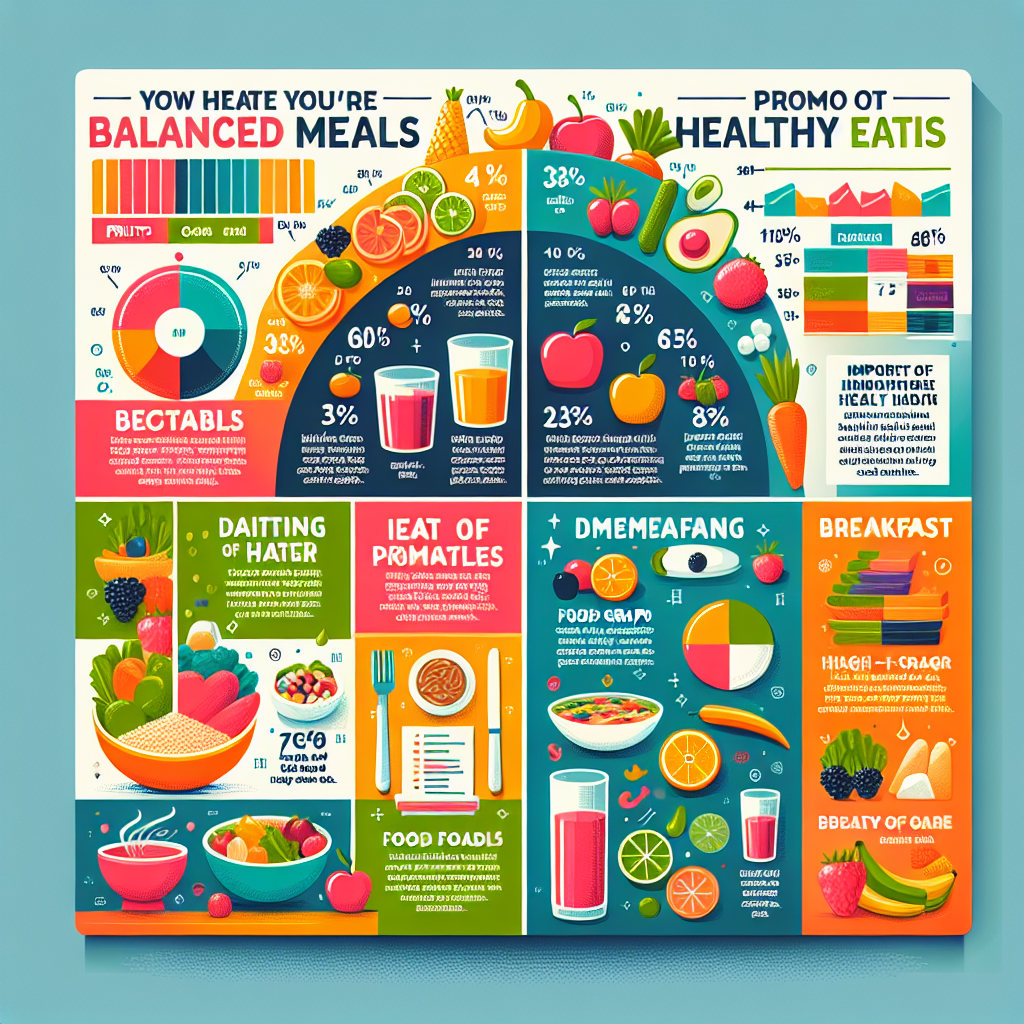-
Table of Contents

“Fuel Your Life: Master the Art of Balanced Meals and Healthy Eating Habits”
Introduction
Creating balanced meals and cultivating healthy eating habits are essential components of a well-rounded lifestyle. A balanced meal typically includes a variety of nutrients from different food groups, ensuring that the body receives the vitamins, minerals, and energy it needs to function optimally. Healthy eating habits go beyond just the food on your plate; they encompass mindful eating practices, portion control, and making informed food choices. By focusing on these aspects, individuals can improve their overall health, maintain a healthy weight, and reduce the risk of chronic diseases. This guide provides practical tips for creating balanced meals and establishing healthy eating habits that can be easily integrated into daily life.
Top 10 Tips for Creating Balanced Meals That Nourish Your Body
Creating balanced meals that nourish your body is an essential aspect of maintaining overall health and well-being. By incorporating a variety of nutrient-dense foods into your diet, you can ensure that your body receives the vitamins, minerals, and energy it needs to function optimally. To help you on this journey, here are ten tips for creating balanced meals that will inspire you to adopt healthy eating habits.
First and foremost, it is crucial to include a variety of fruits and vegetables in your meals. These colorful foods are packed with essential nutrients, antioxidants, and fiber, which support your immune system and promote digestive health. Aim to fill half of your plate with fruits and vegetables at each meal, and try to incorporate a rainbow of colors to maximize the range of nutrients you consume.
In addition to fruits and vegetables, incorporating whole grains into your diet is another key component of balanced meals. Whole grains, such as brown rice, quinoa, and whole wheat bread, provide a steady source of energy and are rich in fiber, which helps regulate blood sugar levels and keeps you feeling full longer. Replacing refined grains with whole grains can make a significant difference in your overall health.
Protein is another essential element of a balanced meal. Including a variety of protein sources, such as lean meats, fish, eggs, beans, and nuts, ensures that your body receives the necessary amino acids for muscle repair and growth. Additionally, plant-based proteins can offer a wealth of other nutrients and are often lower in saturated fats compared to animal proteins.
Healthy fats are also an important part of a balanced diet. Incorporating sources of unsaturated fats, such as avocados, olive oil, and nuts, can help support heart health and provide essential fatty acids that your body cannot produce on its own. It is important to moderate your intake of saturated and trans fats, which are commonly found in processed and fried foods, as they can contribute to heart disease and other health issues.
Hydration is another critical aspect of maintaining a balanced diet. Drinking plenty of water throughout the day helps regulate body temperature, supports digestion, and keeps your skin healthy. Aim to drink at least eight glasses of water daily, and consider incorporating herbal teas or infused water for added flavor and health benefits.
Portion control is also vital when creating balanced meals. Being mindful of portion sizes can help prevent overeating and ensure that you are consuming the right amount of nutrients without excess calories. Using smaller plates, measuring portions, and listening to your body’s hunger cues can all contribute to better portion control.
Planning and preparing meals in advance can also support healthy eating habits. By dedicating time each week to plan your meals and prepare ingredients, you can ensure that you have nutritious options readily available, reducing the temptation to opt for less healthy convenience foods.
Mindful eating is another practice that can enhance your relationship with food. Taking the time to savor each bite, eating slowly, and paying attention to your body’s signals of hunger and fullness can help you enjoy your meals more and prevent overeating.
Lastly, it is important to be flexible and forgiving with yourself. Developing healthy eating habits is a journey, and it is natural to have occasional indulgences or setbacks. The key is to focus on making consistent, positive choices and to view each meal as an opportunity to nourish your body.
By incorporating these tips into your daily routine, you can create balanced meals that support your overall health and well-being. Remember, the goal is to nourish your body with a variety of nutrient-dense foods, practice mindful eating, and enjoy the process of creating a healthier lifestyle.
How to Develop Healthy Eating Habits: A Step-by-Step Guide
Developing healthy eating habits is a journey that requires dedication, mindfulness, and a willingness to make gradual changes. The first step in this journey is understanding the importance of balanced meals. A balanced meal typically includes a variety of food groups, ensuring that your body receives the essential nutrients it needs to function optimally. Incorporating a mix of proteins, carbohydrates, fats, vitamins, and minerals can help you achieve this balance. For instance, a meal consisting of grilled chicken, quinoa, steamed vegetables, and a side of avocado provides a well-rounded array of nutrients.
Transitioning to healthier eating habits can be daunting, but starting small can make the process more manageable. Begin by incorporating more whole foods into your diet. Whole foods, such as fruits, vegetables, whole grains, and lean proteins, are minimally processed and packed with nutrients. Gradually replacing processed foods with these healthier options can significantly improve your overall diet. For example, swapping out sugary cereals for oatmeal topped with fresh berries and nuts can be a simple yet effective change.
Another crucial aspect of developing healthy eating habits is mindful eating. This practice involves paying full attention to the experience of eating and savoring each bite. By slowing down and appreciating your food, you can better recognize your body’s hunger and fullness cues, which can prevent overeating. Additionally, mindful eating encourages you to make more thoughtful food choices, leading to a more balanced diet. To start, try setting aside time for meals without distractions, such as television or smartphones, and focus on the flavors, textures, and aromas of your food.
Planning and preparation are also key components of maintaining healthy eating habits. Meal planning can help you make more nutritious choices and avoid the temptation of unhealthy options. Set aside time each week to plan your meals and create a shopping list based on your plan. Preparing meals in advance, such as batch cooking or prepping ingredients, can save time and reduce the likelihood of resorting to convenience foods. For instance, preparing a large pot of vegetable soup on Sunday can provide you with a quick and healthy lunch option throughout the week.
In addition to planning, staying hydrated is essential for overall health and can support your healthy eating efforts. Drinking water throughout the day helps regulate your appetite and can prevent overeating. Aim to drink at least eight glasses of water daily, and consider carrying a reusable water bottle to remind yourself to stay hydrated. If you find plain water unappealing, try infusing it with fresh fruits or herbs for added flavor.
Lastly, it’s important to remember that developing healthy eating habits is a gradual process, and it’s okay to indulge occasionally. Allowing yourself to enjoy your favorite treats in moderation can prevent feelings of deprivation and help you maintain a balanced approach to eating. The key is to focus on overall patterns rather than perfection. Celebrate your progress and be patient with yourself as you work towards a healthier lifestyle.
By incorporating these tips into your daily routine, you can create balanced meals and develop sustainable healthy eating habits. Embrace the journey with an open mind and a positive attitude, knowing that each small step brings you closer to a healthier, more vibrant life.
Q&A
1. **Question:** What are some key components of a balanced meal?
**Answer:** A balanced meal typically includes a variety of foods from different food groups: lean proteins (such as chicken, fish, beans), whole grains (like brown rice, quinoa), healthy fats (such as avocados, nuts), and a variety of fruits and vegetables. It should also include adequate hydration, usually in the form of water.
2. **Question:** What are some healthy eating habits to adopt?
**Answer:** Healthy eating habits include eating regular, balanced meals, incorporating a variety of foods to ensure nutrient diversity, practicing portion control, limiting processed and high-sugar foods, staying hydrated, and listening to your body’s hunger and fullness cues.
Conclusion
Creating balanced meals and healthy eating habits involves incorporating a variety of nutrient-dense foods, practicing portion control, and maintaining regular meal times. Emphasize whole grains, lean proteins, healthy fats, and a colorful array of fruits and vegetables. Limit processed foods, added sugars, and excessive salt. Stay hydrated and listen to your body’s hunger and fullness cues. Planning meals ahead and being mindful of your eating environment can also support healthier choices. By adopting these practices, you can improve overall health, maintain energy levels, and reduce the risk of chronic diseases.



